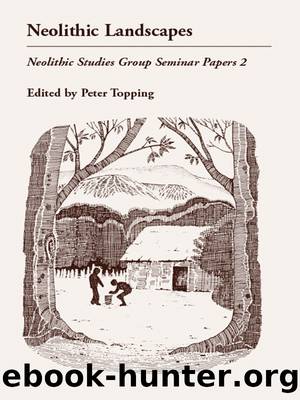Neolithic Landscapes by Peter Topping

Author:Peter Topping
Language: eng
Format: epub
Publisher: Casemate Publishers & Book Distributors, LLC
Published: 2017-05-15T00:00:00+00:00
THE NEOLITHIC OF THE BLACKWATER
Wherever large scale excavation has taken place on the gravels north of the Blackwater Estuary, Neolithic occupation has been revealed, usually in the form of pit groups. Finds from these features comprise flintwork and Mildenhall style pottery, predominantly plain but with some decorated material. Typical of the kind of evidence encountered are the pits from Lofts Farm (Brown 1988). Comparable evidence has been revealed elsewhere within the Lofts Farm cropmark complex (Brown, P. et al 1984 - 5), from Chigborough, Howells and Slough House Farms (Wallis and Waughman forthcoming), Heybridge (Brown 1986), Heybridge Basin (Brown and Adkins 1988) and from recent excavations at Elms Farm. Carbonized plant remains recovered from all these sites were remarkably sparse (Murphy pers. comm, and forthcoming).
At least one very substantial posthole was present at Lofts Farm (Brown 1988, 252) where the pits appear to have been left open for a time before being backfilled. This allowed a stoney, sandy layer derived from the surrounding gravel to accumulate. Such a sequence is reminiscent of pits within parts of the enclosure complex at Hambledon Hill (Mercer 1980, 1988). However, owing to the unstable nature of features cut into the gravels, the Lofts Farm pits may only have been open for a short period.
At Elms Farm Neolithic features include a substantial pit, with large quantities of Mildenhall pottery reminiscent of the deposits in the Springfield Lyons Causewayed enclosure, and again comprising large parts of individual pots. Other pits produced substantial sherds of Mortlake style Peterborough Ware, an East Anglian Style Beaker, substantial parts of two further Beakers and a small quantity of Grooved Ware have also been recovered. A ringditch associated with cremation burials in Deverel-Rimbury urns was located nearby. This would appear to indicate a long lived focus of ritual/funerary activity.
An amorphous feature recorded at Chigborough Farm yielded a large quantity of early neolithic pottery; this feature lay about 35m south of a rectangular post built structure (Wallis and Waughman forthcoming). Finds from this building were sparse but included a fine Mildenhall rim sherd decorated with ripple burnish, unabraded, and possibly deliberately included in the fill of one of the postholes. The structure is just under 8m x 8m with an internal division, the dimensions are comparable to the âhouseâ from Fengate (Pryor 1974, 1993), and the plan is distinctly reminiscent of the central segment of the long Neolithic building at Lismore Fields, Derbyshire (Garton 1987). A row of close set posts runs for about 50m east-north-east/west-south-west, from just east of the south-east corner of the building. These posts have no clear dating evidence but run at variance to extensive later field systems and might be of Neolithic date. A few pits with small sherds of Peterborough Ware and Grooved Ware, occurred south of the building and possible post row.
At nearby Slough House Farm shallower pits, with early Neolithic pottery (in this case, possibly Grimston Ware), Grooved Ware and Beaker were recovered. A rectangular enclosure about 27m x 12m aligned roughly east-west was defined by narrow steep sided gullies/palisade slots (Wallis and Waughman forthcoming).
Download
This site does not store any files on its server. We only index and link to content provided by other sites. Please contact the content providers to delete copyright contents if any and email us, we'll remove relevant links or contents immediately.
| Africa | Americas |
| Arctic & Antarctica | Asia |
| Australia & Oceania | Europe |
| Middle East | Russia |
| United States | World |
| Ancient Civilizations | Military |
| Historical Study & Educational Resources |
The Daily Stoic by Holiday Ryan & Hanselman Stephen(2703)
The Fate of Rome: Climate, Disease, and the End of an Empire (The Princeton History of the Ancient World) by Kyle Harper(2429)
People of the Earth: An Introduction to World Prehistory by Dr. Brian Fagan & Nadia Durrani(2345)
Ancient Worlds by Michael Scott(2098)
Babylon's Ark by Lawrence Anthony(2066)
Foreign Devils on the Silk Road: The Search for the Lost Treasures of Central Asia by Peter Hopkirk(2052)
India's Ancient Past by R.S. Sharma(1982)
MOSES THE EGYPTIAN by Jan Assmann(1968)
The Complete Dead Sea Scrolls in English (7th Edition) (Penguin Classics) by Geza Vermes(1836)
Lost Technologies of Ancient Egypt by Christopher Dunn(1796)
The Daily Stoic by Ryan Holiday & Stephen Hanselman(1764)
The Earth Chronicles Handbook by Zecharia Sitchin(1742)
24 Hours in Ancient Rome by Philip Matyszak(1675)
Alexander the Great by Philip Freeman(1642)
Aztec by Gary Jennings(1539)
The Nine Waves of Creation by Carl Johan Calleman(1518)
Curse Tablets and Binding Spells from the Ancient World by Gager John G.;(1509)
Before Atlantis by Frank Joseph(1481)
Earthmare: The Lost Book of Wars by Cergat(1465)
